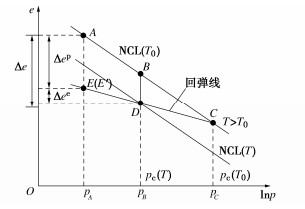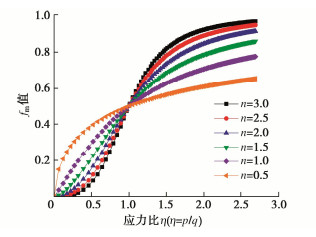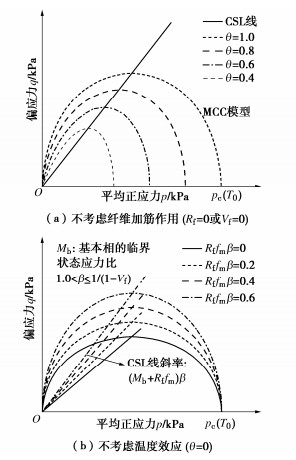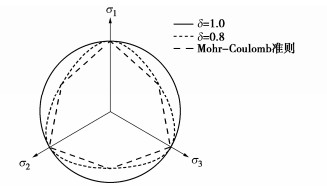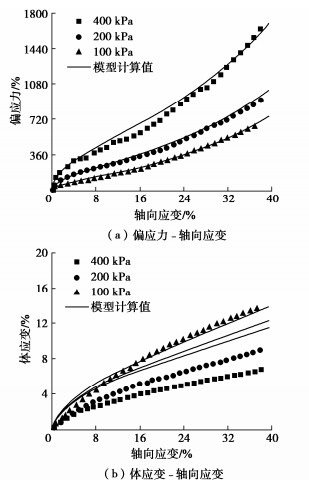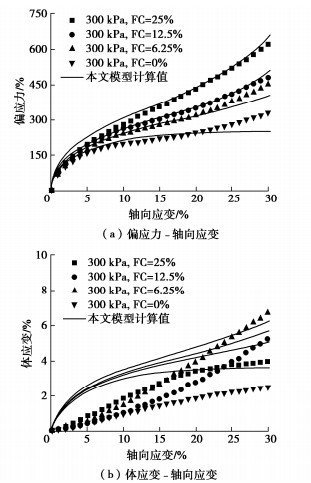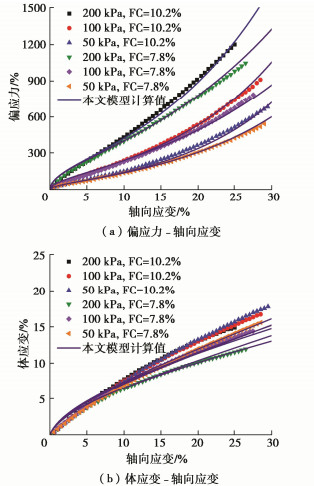Thermo-elastoplastic constitutive model for municipal solid waste (MSW) considering temperature effects and fiber reinforcement
-
摘要: 考虑填埋场内垃圾土成分的复杂性和有机质降解产热导致的温度升高,根据不同温度不同纤维材料含量垃圾土的三轴试验结果,表明温度和纤维材料是影响垃圾土力学特性的关键因素,由此将垃圾土看作是类土材料和纤维材料的复合体。荷载作用下垃圾土的力学特性取决于类土材料和纤维材料的共同作用,认为温度变化只影响垃圾土的体积变形,提出了考虑温度效应的塑性体应变的硬化规律和纤维材料加筋作用的演化方程。通过构建一个新的反映温度效应和纤维加筋作用的塑性势函数,并依据相关联流动性法则导出了适用于垃圾土的热-弹塑性本构模型。通过对比文献中已有垃圾土的三轴试验结果,表明模型计算值与试验结果具有较高的吻合程度,能够很好地模拟垃圾土应力–应变曲线上翘和体应变持续增加的变化特征,以及较高围压下强度较大、较高纤维含量强度较大、较高温度下强度较小的垃圾土力学特性;在体积变形预测方面,模型计算值与试验结果虽有所偏差,但还是较好地捕捉到了较高围压下体应变较小、较高纤维含量体应变有所增大、较高温度下体应变略大的变形特征。由此可见,所建垃圾土的本构模型能够较为准确地反映围压、纤维含量以及温度对垃圾土应力–应变关系特性的影响规律,有效验证了模型的合理性。Abstract: Considering the composition complexity of municipal solid waste (MSW) and the temperature rise caused by degradation of organic matters, according to the triaxial test results of MSW with different fiber contents under different temperatures, it is shown that the temperatures and fiber materials are the key factors affecting the mechanical properties of MSW. Therefore, MSW can be regarded as a composite of soil-like materials and fiber materials, whose mechanical properties depend on the combined interaction of the two materials. It is assumed that the temperatures only affect the volumetric deformation of MSW, and the fiber reinforcement effects are gradually apparent during loading. Based on this, the hardening law of plastic volumetric strain considering the temperature effects and the evolution equation reflecting the reinforcement effects of fiber materials are both proposed. Through the new plastic potential function developed with reflecting the effects of the temperatures and fiber reinforcement, the thermo-elastoplastic constitutive model is derived for MSW using the associated flow rule. Compared with the test results of different MSW, those of the proposed model are in good agreement with the test data. The main features of upward curvature of stress-strain curves and continuously increasing volumetric strain with axial stain are better reproduced by the proposed model as well as other mechanical properties of MSW such as the greater strength under higher confining pressure, greater strength with higher fiber content, and lower strength at higher temperatures. Although the calculations of the proposed model have some deviation from the test results in terms of volume change behaviors, the main volume deformation characteristics of MSW are well captured by the proposed model, including the smaller volumetric strain under higher confining pressure, lager volumetric strain with higher fiber content, and slightly larger volumetric strain at higher temperature. In conclusion, the proposed model can accurately reflect the influences of confining pressure, fiber content and temperature on the stress-strain and volumetric strain behavior of MSW, which effectively verifies the retionality of the constitutive model.
-
0. 引言
随着交通科技的快速发展,中国桥梁建设水平大幅提升,桥梁跨越能力也越来越大,以满足日益增长的交通运输需求,其中悬索桥单跨最大跨径已接近2000 m,跨越能力最强。
悬索桥主要受力构件包括锚碇、塔和主缆,锚碇作为主要承力结构物,一般都采用重力式锚碇,且锚碇基础底板设置于下部持力层上,是支承主缆、保证全桥主体结构受力稳定的关键部位。重力式锚碇包括沉井基础,地连墙基础,复合锚碇基础等。目前国内大跨径桥锚碇基础一般选用沉井基础或者地下连续墙基础。埋置于地下的锚碇基础受到岩土体的支撑及侧向约束作用,特别是变形控制问题需要考虑岩土体与锚碇基础的共同作用,为此提出上部采用沉井基础下部采用钻孔灌注桩的复合锚碇基础形式以满足结构稳定和变形的要求,即桩碇组合结构。桩碇组合结构作为一种新型锚碇基础需要展开针对性研究,传统悬索桥沉井基础与桩碇组合结构基础的结构型式如图1所示。国内外典型大跨径的悬索桥锚碇基础见表1所示。图2给出了悬索主缆拉力随着跨径增加示意图,由图2可见悬索桥跨径随跨径呈非线性增加,从而对锚碇基础提出了更高要求,图3给出了锚碇基础占总造价随悬索桥跨径的变化情况,因此需要对锚碇基础进行深入研究。
表 1 国内外典型大跨径悬索桥重力式锚碇基础Table 1. Typical caisson anchorages of long-span suspension bridges桥名 桥型 主跨径/m 锚碇基础尺寸/m 基础持力层 明石海峡大桥 悬索桥 1990 神户侧(地连墙Φ85×63.5) 沉积岩 淡路侧(沉井80×63×26) 花岗岩 南京仙新路大桥 悬索桥 1760 南锚碇(地连墙Φ68×64) 微风化砾岩 杨泗港长江大桥 悬索桥 1700 南锚碇(地连墙Φ98×36) 坚硬黏土层 北锚碇(地连墙Φ98×44) 坚硬黏土层 虎门二桥 悬索桥 1688 东锚碇(地连墙Φ90×29) 泥岩 西锚碇(地连墙Φ90×35.2) 泥质粉砂岩 西堠门大桥 悬索桥 1650 南锚碇(扩大基础63.6×74.7×50.3) 微风化岩石 北锚碇(扩大基础60.0×81.7×50) 微风化岩石 丹麦大贝尔特桥 悬索桥 1624 两侧锚碇(沉井78×35×20) 砾石 南京长江四桥 悬索桥 1418 南锚碇(地连墙58.2×44.2×76.0) 密实卵砾石 北锚碇(沉井69×51×58) 含砾中粗砂 泰州长江大桥 悬索桥 1080+1080 南锚碇(沉井67.9×52×41) 粉砂 北锚碇(沉井67.9×52×57) 粗砂 马鞍山长江大桥 悬索桥 1080 南锚碇(沉井60.2×55.4×48.0) 圆砾土 北锚碇(沉井60.2×55.4×41.0) 中密中砂 武汉鹦鹉洲大桥 悬索桥 850 南锚碇(Φ66×29) 微风化岩石 北锚碇(Φ66×43) 砾砂 1. 国内外研究现状
陈晓平等[1]、徐涛等[2]以不同沉井基础为研究对象,对其下沉施工进行了全过程实时监测,并利用实测资料系统分析了沉井的下沉机理和受力特性,得到了井壁侧摩阻力和刃脚端阻力的大小和分布特征,以及侧摩阻力沿深度呈抛物线形分布的规律。李宗哲等[3]采用钢筋应力计和土压力计分别监测沉井在下沉过程中的侧摩阻力和刃脚土压力,得到了每节沉井的侧摩阻力、沉井与土层的摩擦系数以及刃脚土压力结果,利用监测数据控制了沉井的安全平稳下沉。邓友生等[4]基于武汉鹦鹉洲长江大桥北锚碇大型圆形沉井的施工过程,建立了沉井和周边土体的三维计算模型,分析了沉井结构及其周围的地下连续防护墙在下沉与封底过程中的应力分布与变形情况,并研究了沉井下沉过程对周边环境的影响。
邓燕羚[5]针对国内首个伴随台风影响的强潮河口处深厚淤泥层地质下的超大型水中沉井基础,通过比较完整的现场实测数据和相应的理论计算研究,采用先进的数值模拟分析方法,对该沉井基础在下沉施工过程中的复杂受力性能、下沉稳定性和地基土体的承载能力进行系统、深入地分析。张计炜[6]以温州市瓯江北口大桥中塔沉井基础为研究对象,采用现场监测、理论计算和数值分析相结合的方法,在全面研究深厚软土层中超大沉井施工下沉全过程的基底端阻力和侧壁摩阻力受力特性及变化规律的基础上,进一步分析沉井下沉前期淤泥层中的突沉机理及相应预防措施,并通过对比分析探索不同施工工况对沉井下沉过程的影响。桩碇组合结构复合锚碇基础在国外已有采用,但由于工程实例少,在国内很少被人注意,目前尚没有采用桩碇组合结构的报导。
2. 基于规范的锚碇设计方法
悬索桥的锚碇设计主要是基于《公路桥涵地基与基础设计规范》JTG D63—2007[7]和《公路悬索桥设计规范》JTG/T D65—05—2015[8]两本规范的相关条款执行。承载力角度需要验算基底承载力、基础稳定和抗滑,将锚碇抽象为刚体的计算简图,不考虑锚碇周围土体的提供约束荷载,得到偏于安全的计算结果。根据《公路悬索桥设计规范》JTG/T D65—05—2015的8.4.2条要求锚碇前、后端基底在施工、运营阶段应不出现拉应力,对基底应力的最大值也提出了要求;同时在8.4.3节对运营阶段锚碇允许水平变位提出不宜大于1 ‱倍的主跨跨径,竖向变位不宜大于2 ‱倍的主跨跨径要求。
3. 基于机理分析的锚碇设计方法
不论是传统的锚碇基础还是改进后的桩碇组合结构基础,基于基础与岩土体的相互作用以及锚碇施工至后期的运营考虑,都需要建立更为真实反应实际物理过程的计算分析模型,才能得到较为合理的计算结果,为锚碇基础的全生命周期运营过程提供数据支撑。分析中需要重点考虑以下几点:①在缆索传递的荷载作用下,锚碇基础、岩土体以及二者之间的界面关系;②地基中的成层饱和土受荷后产生的超孔隙水压力消散;③基础受到水浮力作用。因此,岩土层需要选用刚度非线性并且采用有效应力指标的本构模型,如黏土以及砂性土等土层采用土体硬化模型(HS)以及在此基础上演化而来的考虑小刚度的土体硬化模型(HSS),而反应Mohr-Coulomb强度的黏聚力和内摩擦角均需要采用有效指标,可由固结排水试验获得。HS本构模型应力应变曲线,以及在主应力空间的屈服面分别见图4和图5所示。土体的刚度具有典型的应力依赖性,加载非线性,而且卸载模量与加载不同,因此需要采用HS本构模型或者其演化的本构模型进行计算分析。
由表1可知,很多锚碇基础均嵌入到岩层中,能够反应岩石风化以及节理分布的本构模型为Hoek-Brown模型,该模型不仅引入了地质参数GSI、岩石完整参数
mi 和施工扰动参数D,且可以与传统的岩石本构Mohr-Coulomb参数进行一定的转换,为参数确定提供了便捷。霍克布朗破坏准则采用最大主应力σ1 和最小主应力σ3 的关系式见式(1)所示,式中的参数由式(2)~(4)来确定。σ1=σ3+σc(mbσ3σc+s)a, (1) mb=miexp(GSI−10028−14D), (2) s=exp(GSI−1009−3D), (3) a=12+16[exp(−GSI15)−exp(−203)]。 (4) 岩土层与锚碇基础的界面表达也尤为重要,界面反应相互接触的两种介质的行为,特别是土体的非线性导致界面的非线性,因此需要建立能够反应岩土体的刚度非线性的界面刚度,强度可以通过相邻土体的黏聚力和内摩擦角计算得到的抗剪强度进行控制。对于大型复杂的三维计算分析,沉井基础以及群桩可分别简化为板和桩,桩与岩土体的相互作用用三向弹簧表示,即与桩身轴线相垂直的两个法向弹簧和与之平行的一个剪切弹簧,如图6所示,弹簧刚度则通过周围岩土层的非线性本构模型参数确定。
4. 结语
由于岩土层复杂多变以及悬索桥已有基础或新型基础与岩土层的界面的复杂性,需要在原有规范基础以及机理分析基础上系统开展锚碇基础的深入研究。结合模型试验、现场实测数据及数值模拟分析对不同桩径、桩长、嵌岩深度及土层条件的桩碇组合结构荷载传递机理及变形破坏规律进行研究,提出大跨度悬索桥桩碇组合结构的设计方法,丰富悬索桥锚碇的设计体系。基于室内模型试验及依托工程的计算分析,建立考虑接触及岩土体非线性行为的桩碇组合结构设计计算分析方法,提出桩碇组合结构优化设计方案,为新型复合锚碇基础的推广应用提供技术支撑。
-
图 5 模型计算值与文献[10]中试验结果的对比情况
Figure 5. Comparison between values by proposed model and test results by Machado et al
表 1 模型参数
Table 1 Model parameters
文献 λ κ μb e100 φc/(°) Δφ/(°) μf a1 a2 a3 α ξ Machado等[11] 0.163 0.006 0.3 1.93 22.0 3.21 0.45 7.88 0.43 0.138 — — Karimpour-Fard等[23] 0.456 0.030 0.3 2.13 19.2 3.00 0.45 41.46 9.51 0.245 — — Ramaiah等[24] 0.150 0.020 0.3 1.73 28.6 4.87 0.45 15.96 0.30 0.204 — — 姜兆起[25] 0.327 0.042 0.3 1.62 27.5 0.29 0.45 18.56 0.43 0.131 0.06 0.067 -
[1] EID H T, STARK T D, EVANS W D, et al. Municipal solid waste slope failure Ⅰ: waste ans foundation soil properties[J]. Journal of Geotechnical and Geoenvironmental Engineering, 2000, 126(5): 408–419. doi: 10.1061/(ASCE)1090-0241(2000)126:5(408)
[2] BLIGHT G. Slope failures in municipal solid waste dumps and landfills: a review[J]. Waste Management & Research, 2008, 26(5): 448–463.
[3] FENG S J, CHANG J Y, SHI H, et al. Failure of an unfilled landfill cell due to an adjacent steep slope and a high groundwater level: a case of study[J]. Engineering Geology, 2019: 105320.
[4] SINGH M K, VILAR O M, CARVALHO M F. Application of a hyperbolic model to municipal solid waste[J]. Géotechnique, 2011, 61(7): 533–547. doi: 10.1680/geot.8.P.051
[5] 柯瀚, 郭城, 陈云敏, 等. 考虑降解效应的城市固体废弃物非线性本构模型[J]. 岩土力学, 2014, 35(5): 1217–1223. https://www.cnki.com.cn/Article/CJFDTOTAL-YTLX201405001.htm KE Han, GUO Cheng, CHEN Yun-min, et al. A nonlinear constitutive model for municipal solid waste considering effects of degradation[J]. Rock and Soil Mechanics, 2014, 35(5): 1217–1223. (in Chinese) https://www.cnki.com.cn/Article/CJFDTOTAL-YTLX201405001.htm
[6] 陈云敏, 高登, 朱斌. 城市固体废弃物的复合指数应力–应变模型研究[J]. 岩土工程学报, 2009, 31(7): 1020–1029. http://manu31.magtech.com.cn/Jwk_ytgcxb/CN/abstract/abstract13307.shtml CHEN Yun-min, GAO Deng, ZHU Bin. Composite exponential stress-strain model of municipal solid waste and its application[J]. Chinese Journal of Geotechnical Engineering, 2009, 31(7): 1020–1029. (in Chinese) http://manu31.magtech.com.cn/Jwk_ytgcxb/CN/abstract/abstract13307.shtml
[7] 李修磊, 李金凤. 城市生活垃圾土的变形强度特性及其应力–应变模型[J]. 水文地质工程地质, 2016, 43(5): 70–75. https://www.cnki.com.cn/Article/CJFDTOTAL-SWDG201605010.htm LI Xiu-lei, LI Jin-feng. A study of deformation and strength properties and stress-stain model for municipal solid waste (MSW) [J]. Hydrogeology and Engineering Geology, 2016, 43(5): 70–75. (in Chinese) https://www.cnki.com.cn/Article/CJFDTOTAL-SWDG201605010.htm
[8] SIVAKUMAR BABU G L, LAKSHMIKANTHAN P, SANTHOSH L G. Shear strength characteristics of mechanically biologically treated municipal solid waste (MBT-MSW) from Bangalore[J]. Waste Management (New York, N Y), 2015, 39: 63–70. doi: 10.1016/j.wasman.2015.02.013
[9] CHOUKSEY S K, SIVAKUMAR BABU G L. Constitutive model for strength characteristics of municipal solid waste[J]. International Journal of Geomechanics, 2015, 15(2): 04014040. doi: 10.1061/(ASCE)GM.1943-5622.0000351
[10] MACHADO S L, CARVALHO M F, VILAR O M. Constitutive model for municipal solid waste[J]. Journal of Geotechnical and Geoenvironment Engineering, 2002, 128(11): 940–951. doi: 10.1061/(ASCE)1090-0241(2002)128:11(940)
[11] MACHADO S L, VILAR O M, CARVALHO M F. Constitutive model for long term municipal solid waste mechanical behavior [J]. Computers and Geotechnics, 2008, 35(5): 775–790. doi: 10.1016/j.compgeo.2007.11.008
[12] MACHADO S L, VILAR O M, CARVALHO M D F, et al. A constitutive framework to model the undrained loading of municipal solid waste [J]. Computers and Geotechnics, 2017, 85(2): 207–219.
[13] CHANG J Y, FENG S J. A constitutive model for municipal solid waste incorporating bounding surface plasticity and reinforcing effect[J]. Computers and Geotechnics, 2020, 123: 103592 doi: 10.1016/j.compgeo.2020.103592
[14] LÜ X, ZHAI X, HUANG M. Characterization of the constitutive behavior of municipal solid waste considering particle compressibility[J]. Waste Management (New York), 2017, 69: 3–12. doi: 10.1016/j.wasman.2017.08.003
[15] 李修磊, 施建勇, 李金凤. 考虑纤维加筋作用的城市生活垃圾土弹塑性本构模型[J]. 岩土力学, 2019, 40(5): 1916–1924. https://www.cnki.com.cn/Article/CJFDTOTAL-YTLX201905034.htm LI Xiu-lei, SHI Jian-yong, LI Jin-feng. Elastoplastic constitutive model for municipal solid waste considering the effect of fibrous reinforcement[J]. Rock and Soil Mechanics, 2019, 40(5): 1916–1924. (in Chinese) https://www.cnki.com.cn/Article/CJFDTOTAL-YTLX201905034.htm
[16] HANSON J L, YESILLER N, OETTLE N K. Spatial and temporal temperature ditributions in municipal solid waste landfills[J]. Journal of Environmental Engineering, 2010, 136(8): 804–814. doi: 10.1061/(ASCE)EE.1943-7870.0000202
[17] LUETTICH S M, YAFRATE N. Measuring temperatures in an elevated temperature landfills[C]// Geo-Chicago, Chicago, Illinois, United States, 2016, GSP, Chicago.
[18] STARK T D, AKHTAR K, HUSSAIN M. Stability analysis for a landfill experiencing elevated temperature[C]// Geo-Florida, Orlando, Florida, United States, ASCE, 2010, Orlando.
[19] 姚祖强. 不同温度及含水率条件下垃圾土降解产热研究[D]. 南京: 河海大学, 2021. YAO Zu-qiang. The Heat Generation of Waste Degradation under Different Initial Temperatures and Water Contents[D]. Nanjing: Hohai University, 2015. (in Chinese)
[20] LIU X, SHI J, QIAN X, et al. One-dimensional model for municipal solid waste (MSW) settlement considering coupled mechanical-hydraulic-gaseous effect and concise calculation [J]. Waste Management (New York), 2011, 31(12): 2473–2483. doi: 10.1016/j.wasman.2011.07.013
[21] LALOUI L, CEKEREVAC C. Thermo-plasticity of clays: An isotropic yield mechanism[J]. Computers and Geotechnics, 2003, 30: 649–660. doi: 10.1016/j.compgeo.2003.09.001
[22] FARVERO V, FERRARI A, LALOUI L. Thermo-mechanical volume change behaviour of Opalinus clay[J]. International Journal of Rock Mechanics Mining Sciences, 2016, 90: 15–25. doi: 10.1016/j.ijrmms.2016.09.013
[23] 姚仰平, 杨一帆, 牛雷. 考虑温度影响的UH模型[J]. 中国科学: 技术科学, 2011, 41(2): 158–169. https://www.cnki.com.cn/Article/CJFDTOTAL-JEXK201102004.htm YAO Yang-ping, YANG Yi-fan, NIU Lei. UH model considering temperature effects[J]. Scientia Sinica (Technologica), 2011, 41(2): 158–169. (in Chinese) https://www.cnki.com.cn/Article/CJFDTOTAL-JEXK201102004.htm
[24] ZHOU C, NG C W. A thermomechanical model for saturated soil at small and large strains[J]. Canadian Geotechnical Journal, 2015, 52(8): 1101–1110. doi: 10.1139/cgj-2014-0229
[25] KARADEMIR T, FROST J D. Micro-scale tensile properties of single geotextile polypropylene filaments at elevated temperature[J]. Geotextiles and Geomembranes, 2014, 42(3): 201–213. doi: 10.1016/j.geotexmem.2014.03.001
[26] KARIMPOUR-FARD M, MACHADO S L, SHARIATMADARI N, et al. A laboratory study on the MSW mechanical behavior in triaxial apparatus[J]. Waste Management (New York), 2011, 31(8): 1807–1819. doi: 10.1016/j.wasman.2011.03.011
[27] RAMAIAH B J, RAMANA G V. Study of stress-strain and volume change behavior of emplaced municipal solid waste using large-scale triaxial testing[J]. Waste Management, 2017, 63: 366–379. doi: 10.1016/j.wasman.2017.01.027
[28] 刘祎, 蔡国庆, 李舰, 等. 一个统一描述饱和—非饱和土温度效应的热-弹塑性本构模型[J]. 岩土力学, 2020, 41(10): 3279–3288. https://www.cnki.com.cn/Article/CJFDTOTAL-YTLX202010013.htm LIU Yi, CAI Guo-qing, LI Jian, et al. A unified thermo elstoplastic constitutive model describing the temperature effect of saturated and unsaturated soils[J]. Rock and Soil Mechanics, 2020, 41(10): 3279–3288. (in Chinese) https://www.cnki.com.cn/Article/CJFDTOTAL-YTLX202010013.htm
[29] SHARIATMADARI N, MACHADO S L, NOORZAD A, et al. Municipal solid waste effective stress analysis[J]. Waste Management (New York), 2009, 29(12): 2918–2930. doi: 10.1016/j.wasman.2009.07.009
[30] 姜兆起. 温度影响下高塑料含量垃圾土强度变形特性试验研究[D]. 南京: 河海大学, 2018. JIANG Zhao-qi. Experimental Study on the Strength and Deformation Characteristics of MSW with High Plastic Content Under the Influence of Temperature[D]. Nanjing: Hohai University, 2018. (in Chinese)
-
期刊类型引用(9)
1. 巫茂寅. 素土挤密桩对西北黄土湿陷性影响的试验研究. 中国新技术新产品. 2025(03): 121-123 .  百度学术
百度学术
2. 倪震. 基于分层综合估算法的粉煤灰回填地基承载力研究. 粘接. 2024(02): 147-150 .  百度学术
百度学术
3. 王红肖. 改良黄土抗压强度试验探究. 水利科技与经济. 2024(09): 21-24 .  百度学术
百度学术
4. 刘荆泉,徐昊天,陈文成,陈云泽,章定文. 施工参数对振杆密实法处理液化砂土地基效果的影响研究. 工程勘察. 2024(10): 29-35 .  百度学术
百度学术
5. 化建新,王浩,张丹,梁涛. 地基处理综述及地基处理智能化——第九届全国岩土工程实录交流会特邀报告. 岩土工程技术. 2024(06): 631-643 .  百度学术
百度学术
6. 徐昊天,苟志孝,王正伟,戴梁,章定文. 振杆密实法在高烈度区液化地基处理中的应用研究. 防灾减灾工程学报. 2024(06): 1439-1447 .  百度学术
百度学术
7. 郑圣榆. 国有建筑企业中层管理者绩效考核体系构建研究. 现代企业文化. 2023(09): 137-140 .  百度学术
百度学术
8. 唐文斐. 浅谈西北地区湿陷性黄土地基湿陷机理与处理措施. 房地产世界. 2023(14): 157-159 .  百度学术
百度学术
9. 张振海. 湿陷性黄土地基的沉降规律与特征研究——以某商业楼倾斜事故为例. 重庆建筑. 2022(11): 57-61 .  百度学术
百度学术
其他类型引用(4)




 下载:
下载:





